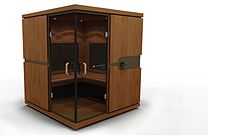Far infrared

Far infrared (FIR) is a region in the infrared spectrum of electromagnetic radiation. Far infrared is often defined as any radiation with a wavelength of 15 micrometers (µm) to 1 mm (corresponding to a range of about 20 THz to 300 GHz), which places far infrared radiation within the CIE IR-B and IR-C bands.[1] Different sources use different boundaries for the far infrared spectrum; for example, astronomers sometimes define far infrared as wavelengths between 25 µm and 350 µm.[2]
Visible light includes radiation with wavelengths between 400 nm and 700 nm, meaning that far infrared photons have less energy than visible light photons.[3]
Applications
Astronomy
Objects with temperatures between about 5 K and 340 K will emit radiation in the far infrared range (see Wien's displacement law and Black-body radiation). This property is sometimes used to observe interstellar gases where new stars are often formed.
For example, the center of the Milky Way Galaxy is very bright in far infrared images because the dense concentration of stars there heats the surrounding dust and causes it to emit radiation in this part of the spectrum. Disregarding the center of our own galaxy, the brightest far infrared object in the sky is the galaxy M82, which radiates as much far infrared light from its central region as all of the stars in the Milky Way combined. This is due to the dust at the center of M82 being heated by an unknown source.[2]
Medicine

Several studies have examined the use of infrared saunas in the treatment of chronic health problems, such as high blood pressure, congestive heart failure and rheumatoid arthritis, and found some evidence of benefit. However, larger and more-rigorous studies are needed to confirm these results.[4]
Evidence that infrared sauna therapy may prove beneficial for clinical use continues to increase as researchers dig deeper. The Alternative Medicine Review reports that "sauna therapy is an effective and underutilized treatment for a variety of cardiovascular problems." The research further states that "persons with class II, III or IV Congestive Heart Failure can experience improvements in CHF-related symptoms from just 15 minutes in low temperature Far infrared sauna sessions, 3-5 times weekly." Studies also conclude that sauna therapy can improve blood pressure in patients with hypertension.[5]
References
- ↑ Byrnes, James (2009). Unexploded Ordnance Detection and Mitigation. Springer. pp. 21–22. ISBN 978-1-4020-9252-7.
- ↑ 2.0 2.1 "Near, Mid and Far-Infrared". Caltech Infrared Processing and Analysis Center. Retrieved 2013-01-28.
- ↑ Gregory Hallock Smith (2006), Camera lenses: from box camera to digital, SPIE Press, p. 4, ISBN 978-0-8194-6093-6
- ↑ Bauer, Brent A. (June 3, 2011). "What is a far-infrared sauna? Does it have health benefits?". Health Information. Mayo Clinic website. Retrieved 1 November 2012.
- ↑ Crinnion, ND, Walter J. (2011). "Sauna as a Valuable Clinical Tool for Cardiovascular, Autoimmune, Toxicant-induced and other Chronic Health Problems". Alternative Medicine Research. Alternative Medicine Review Website. Retrieved 27 January 2014.